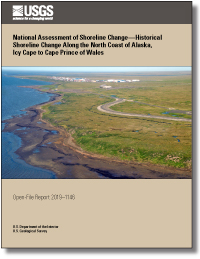National Assessment of Shoreline Change — Historical Shoreline Change Along the North Coast of Alaska, Icy Cape to Cape Prince of Wales
Links
- Document: Report (pdf)
- Data Release: Data Release - National assessment of shoreline change—A GIS compilation of updated vector shorelines and associated shoreline change data for the north coast of Alaska, Icy Cape to Cape Prince of Wales
- NGMDB Index Page: National Geologic Map Database Index Page
- Download citation as: RIS | Dublin Core
Abstract
Beach erosion is a persistent problem along most open-ocean shores of the United States. Along the Arctic coast of Alaska, coastal erosion is widespread and threatens communities, defense and energy-related infrastructure, and coastal habitat. As coastal populations continue to expand and infrastructure and habitat are increasingly threatened by erosion, there is increased demand for accurate information regarding past and present trends and rates of shoreline movement.
Shoreline change was evaluated by comparing three to four historical shoreline positions derived from 1950s-era topographic surveys and black and white aerial photography, 1980s-era color-infrared Alaska High-Altitude Aerial Photography, 2003 natural color aerial photography, and 2010s-era natural color aerial photography. Long-term (1950s–2010s) and short-term (1980s–2010s) shoreline change rates were calculated using linear-regression and end-point methods, respectively, at transects spaced approximately every 50 meters along both the mainland and barrier island coasts.
Shoreline change rates calculated on more than 24,000 individual transects indicate that between 1948 and 2016 the northern coast of Alaska between Icy Cape and Cape Prince of Wales was slightly erosional, with 68 percent of the total transects showing shoreline retreat over the long term and 63 percent over the short term. However, only 9 percent of the total transects showed shoreline retreat greater than 1 meter per year (m/yr) over the long and short term, respectively. Mean rates of shoreline change of −0.2±0.1 and −0.2±0.3 m/yr, were calculated for the long and short term, respectively. Many rates measured were near the limit of our shoreline change uncertainty estimates. Erosion and accretion rates on individual transects ranged from −8.3 to +9.6 m/yr over the long term and −16.0 to +20.0 m/yr over the short-term analysis periods. The highest rates of erosion and accretion were associated with the formation and migration of inlets along barrier island coasts. The highest erosional rates of change were measured in the southern part of the study area between Sullivan Lake and Cape Prince of Wales. The highest accretional rates of change were measured in the northern part of the study area on the open-ocean coast of barrier islands fronting Kasegaluk Lagoon.
Open-ocean exposed shorelines compose 85 percent of all transects and 70 percent were erosional over the long term. Sheltered mainland-lagoon shorelines compose 15 percent of all transects in the study area and 58 percent were erosional over the long term. Although mean shoreline change rates were quite low along all coasts, exposed shorelines retreated at twice the rate (−0.2±0.1 m/yr) of sheltered shorelines (−0.1±0.1 m/yr). Barrier shoreline transects (includes barrier islands, spits, and beaches) compose 49 percent of the total transects and 56 percent of all exposed shoreline transects. Mean shoreline change rates on exposed barrier shorelines were only slightly greater than exposed mainland shorelines (−0.3±0.1 and −0.2±0.1 m/yr, respectively). Mean shoreline change rates on sheltered barrier shorelines were similar to sheltered mainland shorelines (−0.1±0.3 m/yr).
In contrast to the majority of the Nation’s shorelines, for all but three months of the year (July–September), the north coast of Alaska has historically been protected by landfast sea ice from processes such as waves, winds, and currents that typically drive coastal change on beaches in more temperate regions of the world. Projected and observed increases in periods of sea-ice-free conditions, as sea ice melts earlier and forms later in the year, particularly in the autumn, when large storms are more common in the Arctic, suggest that Arctic coasts will be more vulnerable to storm surge and wave energy, potentially resulting in accelerated shoreline erosion and terrestrial habitat loss in the future. Increases in air and sea water temperatures may also increase erosion of the ice-rich, coastal permafrost bluffs present along much of Alaska’s Arctic coast. More frequent shoreline change data collection and analysis in this rapidly changing environment should be considered in order to evaluate shoreline change trends in the future.
Suggested Citation
Gibbs, A.E., Snyder, A.G., and Richmond, B.M., 2019, National assessment of shoreline change — Historical shoreline change along the north coast of Alaska, Icy Cape to Cape Prince of Wales: U.S. Geological Survey Open-File Report 2019–1146, 52 p., https://doi.org/10.3133/ofr20191146.
ISSN: 2331-1258 (online)
Study Area
Table of Contents
- Acknowledgments
- Executive Summary
- Introduction
- Previous National and Northwestern Alaska Shoreline Assessments
- Methods of Analyzing Shoreline Change
- Calculation and Interpretation of Shoreline Change Rates
- Results from Analysis of Historical Shoreline Change
- Discussion and Additional Considerations
- References Cited
| Publication type | Report |
|---|---|
| Publication Subtype | USGS Numbered Series |
| Title | National assessment of shoreline change — Historical shoreline change along the north coast of Alaska, Icy Cape to Cape Prince of Wales |
| Series title | Open-File Report |
| Series number | 2019-1146 |
| DOI | 10.3133/ofr20191146 |
| Publication Date | December 30, 2019 |
| Year Published | 2019 |
| Language | English |
| Publisher | U.S. Geological Survey |
| Publisher location | Reston, VA |
| Contributing office(s) | Pacific Coastal and Marine Science Center |
| Description | Report: vi, 52 p.; Data Release |
| Country | United States |
| State | Alaska |
| Online Only (Y/N) | Y |


